#San Pedro Bay
Text
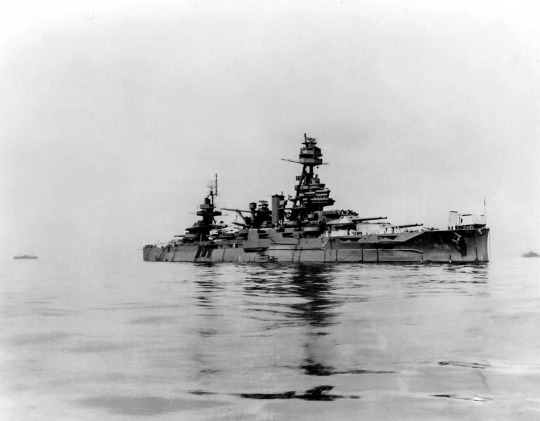
USS TEXAS (BB-35) undergoing post-operation repairs and maintenance while in San Pedro Bay, Leyte Gulf, Philippines. On her bow, a stage is set up for the road show performance of Oklahoma! for the crew's entertainment.
Date: May 17-22, 1945
Texas Parks and Wildlife Department: 2003-1012-52
#USS TEXAS (BB-35)#USS TEXAS#New York Class#battleship TEXAS#Dreadnought#Battleship#Warship#Ship#United States Navy#U.S. Navy#US Navy#USN#Navy#World War II#World War 2#WWII#WW2#WWII History#History#Military History#San Pedro Bay#Leyte Gulf#Philippines#May#1945#my post
69 notes
·
View notes
Text

SIlvery sea off Point Fermin and the Palos Verdes peninsula.
2 notes
·
View notes
Text
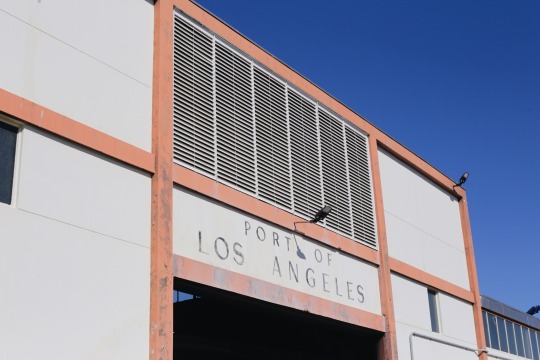

I was laid off today, but I'm joyed to have some more free time
Stay healthy/positive my friends
#original photographers#photographers on tumblr#socal#cali#california#los angeles#San Pedro#south bay#losangeles#palm#palm trees
26 notes
·
View notes
Photo
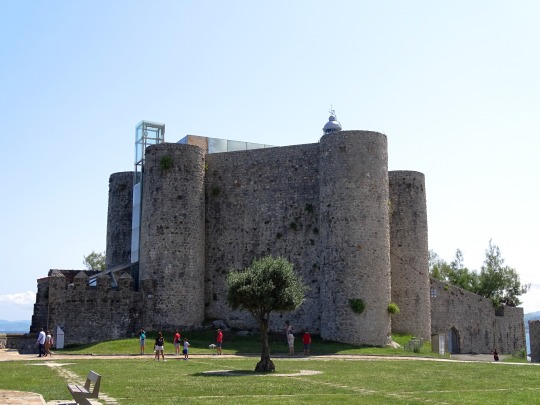



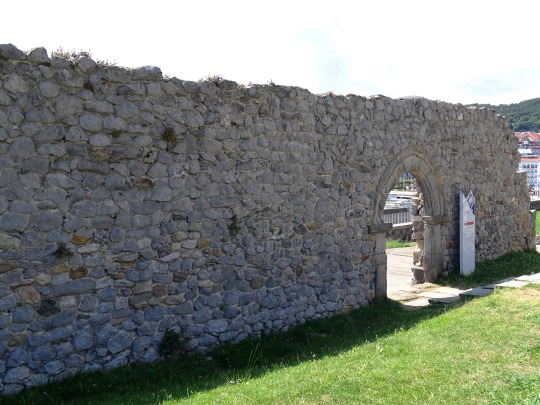
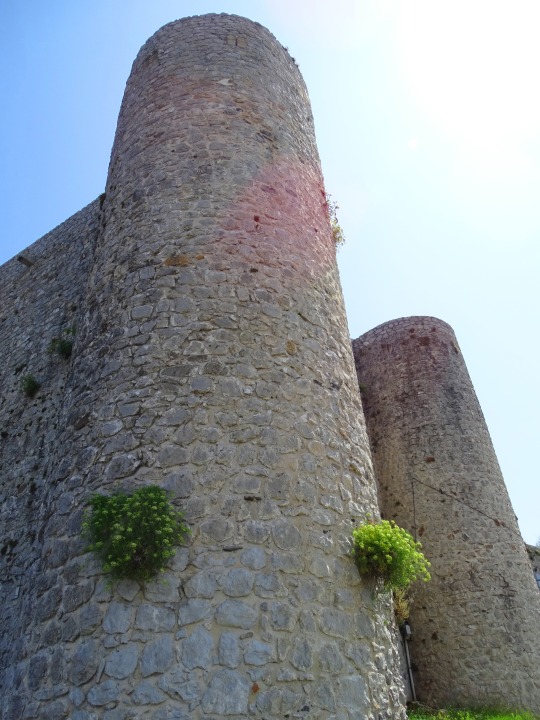


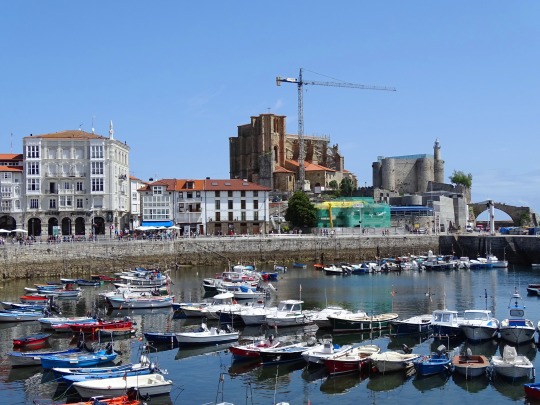

Castle of Santa Ana, Castro Urdiales (No. 1)
The castle of Santa Ana is a fortress located on a rocky promontory in Castro-Urdiales, on a peninsula where there is also the fortified church Sta. Mª de la Asunción (xiii century), the ruins of another previous church (that of San Pedro, from the xii century), and the hermitage of Santa Ana, built as a watchtower, linked to the castle by a bridge. The complex has very good views of the sea, the port and the town. A lighthouse was built inside the enclosure in 1853, whose machinery occupied the chapel. It is one of the best preserved castles in northern Spain.
It has a pentagonal floor plan with cylindrical corner towers 15 meters high, which protect a rectangular enclosure of 22.75 x 12.35 meters; Inside this, in turn, there is a hall of 17 x 7 m covered by a barrel vault. One of the cylinders is actually covering a triangular space that advances from the inner rectangle towards the villa, while the other four act as buttresses of the vault of the living space. Another defense, crenellated and lower, is visible in the part of the lighthouse. It completely lacks gaps, so that the defense could only be done from the towers. The factory is made of cyclopean stones taken with lime. The castle, as well as the citadel, was protected by a wall between 6 and 7 meters high, which preserves a small canvas very deteriorated with the original battlements and merlons.
The access is located on the sea side, through a small door.
It is not known for sure when the castle was founded, speculating that the beginning of the works could coincide with the foundation of the town; However, the founding charter has not reached us. A defensive structure probably existed even earlier.
The current building began its construction in the twelfth century, undergoing various modifications and additions and being abandoned in the sixteenth century.
During a restoration in the twentieth century the lighthouse keeper's house, built inside the enclosure, was demolished. Along with all of Puebla Vieja de Castro-Urdiales, it was declared a historic-artistic site in 1978.
Source: WIkipedia
#Castle of Santa Ana#Castillo de Santa Ana#Faro del castillo de Santa Ana#Santa Ana Castle Lighthouse#Ruinas de Iglesia de San Pedro#España#Ruins of the Church of San Pedro#marina#port#Castro Urdiales#Spain#Bay of Biscay#Cantabric coast#Cantabria#architecture#archaeology#cityscape#tourist attraction#landmark#summer 2021#vacation#Northern Spain#Southern Europe
61 notes
·
View notes
Text
Harbour Terrace Retirement Community: Spacious Studio and One-Bedroom Suites Floor Plans

More Than Just A Room
Harbor Terrace, with its eighty-five spacious and well-equipped apartments, provides a variety of choices. Each private apartment is ready to be individualized with your furniture, family pictures and personal mementos… the treasures you know and love.
Contact Information: (310) 547-0090
Email: [email protected]
Studio Luxury Apartments

Harbor Terrace considers resident security of paramount importance. We feature these premium services that ensure a safe and friendly environment for all our residents:
24-hour staff
Two emergency call systems
Brightly lit hallways and public areas
Automatic sprinkler system
Shower and toilet safety bars
Individually-controlled heat and air-conditioning
Plush carpeting and window coverings
Wet bar complete with a refrigerator, sink and microwave
Residents are welcome to personalize their living areas with their own special comforts of home.
One-Bedroom Suites

We feature these premium services that ensure a safe and friendly living environment
24-hour staff
Four emergency call systems
Automatic sprinkler system
Shower and toilet safety bars
Two full bathrooms
Three closets
Individually-controlled heat and air-conditioning
Plush carpeting and window coverings
Large sliding windows and doors
Wet bar complete with a refrigerator, sink and microwave
Residents are welcome to personalize their living areas with their own special comforts of home.
Finding the perfect retirement community is about more than just location and amenities—it’s also about choosing a living space that provides comfort, convenience, and a sense of home. At Harbour Terrace Retirement Community, residents can enjoy beautifully designed living spaces, with a focus on spacious studio and one-bedroom suites that cater to different needs and lifestyles.
Why Choose Harbour Terrace Retirement Community?
Harbour Terrace stands out among retirement communities due to its focus on providing residents with comfort and independence, all within a secure and welcoming environment. Whether you are looking for a spacious studio or a one-bedroom suite, each floor plan is designed with the individual resident in mind, ensuring a blend of practicality, elegance, and comfort.
1. Spacious Studio Floor Plans
For those looking to simplify their lifestyle, spacious studio suites at Harbour Terrace offer a perfect balance of space and functionality. These suites are ideal for residents who prefer a more compact living arrangement while still enjoying all the modern amenities and comforts of a retirement community.
Key Features of the Spacious Studio Suites:
Open-Plan Layout: The design of the studio suites allows for an easy flow between living, dining, and sleeping areas. This open-plan design makes the space feel larger and more airy.
Efficient Use of Space: Every square foot is utilized thoughtfully, ensuring there’s ample room for relaxation, storage, and movement.
Private Bathroom: The spacious studio suites come equipped with a private bathroom, designed for comfort and accessibility.
Natural Light: Large windows allow for plenty of natural light, making the suite feel bright and welcoming.
Low Maintenance: With a smaller footprint, studio suites are easy to maintain, giving residents more time to enjoy the community’s amenities and activities.
2. One-Bedroom Suites for Added Comfort
For residents who prefer a bit more space and privacy, the one-bedroom suites at Harbour Terrace offer the perfect solution. These suites are designed for those who appreciate having separate living and sleeping areas while still benefiting from all the conveniences of community living.
Features of the One-Bedroom Suites:
Separate Bedroom: The one-bedroom suites provide a distinct bedroom area, offering privacy and a quiet space for rest. The separation of living and sleeping areas creates a more traditional home-like feel.
Spacious Living Room: The living room in the one-bedroom suites offers plenty of space for entertaining guests, relaxing with a good book, or watching TV. This makes it easy to personalize the space to suit your preferences.
Fully Equipped Kitchenette: For residents who enjoy preparing their own meals or snacks, many one-bedroom suites come with a kitchenette, including a refrigerator and storage space for essentials.
Ample Storage: Designed with convenience in mind, the one-bedroom suites provide ample storage options, including closets and cabinets, ensuring residents can bring their favorite belongings without feeling cramped.
Private Bathroom: Just like the studio suites, the one-bedroom suites also come with private bathrooms, fully equipped with safety features for ease of use.
Benefits of Spacious Studio and One-Bedroom Suites
Harbour Terrace takes pride in offering more than just rooms; they provide spacious studio and one-bedroom suites that ensure residents feel at home. Here are some of the key benefits:
1. Independence with Support
The layout and design of the suites allow residents to maintain their independence while also having access to the care and assistance they need. Whether choosing a studio or a one-bedroom, residents can enjoy personal space while knowing help is always nearby.
2. Comfortable Living Spaces
Both the spacious studio and one-bedroom suites are designed to feel like home, with enough room for residents to decorate and arrange their living space as they please. The suites offer all the essentials, so whether it’s a quiet afternoon at home or a visit from family and friends, residents can enjoy their retirement comfortably.
3. Access to Community Amenities
Choosing a spacious studio or one-bedroom suite doesn’t mean sacrificing access to the full range of community services. Harbour Terrace offers a wide variety of amenities, including:
Social and Recreational Activities: From game nights to exercise classes, residents can participate in various activities designed to foster engagement and a sense of community.
Dining Options: Residents enjoy chef-prepared meals, with the choice of dining in the communal areas or preparing small meals in their own kitchenette (available in select one-bedroom suites).
Health and Wellness Services: Harbour Terrace provides access to health and wellness services, including regular check-ups and medication management, all within the comfort of the community.
Tailored to Your Needs
At Harbour Terrace, the spacious studio and one-bedroom suites are tailored to meet individual preferences and needs. Whether you're looking for a cozy, easy-to-maintain space or a larger suite with room for personal belongings and hobbies, Harbour Terrace offers flexible floor plans to suit every lifestyle.
Spacious Studio: Ideal for those who appreciate a simplified lifestyle with everything in one open space.
One-Bedroom Suites: Perfect for those who enjoy separate spaces for sleeping and living, offering a home-like atmosphere.
Conclusion
When it comes to choosing a retirement community, finding the right living space is essential. The spacious studio and one-bedroom suites at Harbour Terrace Retirement Community offer residents a perfect blend of comfort, independence, and convenience. Whether you prefer a more minimalist studio or a larger one-bedroom suite, you’ll find a living space that feels like home at Harbour Terrace.
Explore the spacious studio and one-bedroom suites today and see why Harbour Terrace is the ideal choice for your retirement living.
CONTACT US:
Address: 435 West 8th Street, San Pedro, CA 90731
Phone number: (310) 547-0090
Email: [email protected]
Website: https://harborterraceretirement.com/Tags:Best Independent Assisted Living Community in San Pedro, Best Assisted Living Community in San Pedro, Comfortable retirement community in San Pedro, Becoming a Resident in San Pedro, Modern assisted living in San Pedro California, Modern assisted living in San Pedro, Modern assisted living in San Pedro USA, Modern assisted living in San Pedro ca, Modern comfortable assisted living in USA, Career at Harbor Terrace, Modern comfortable assisted living facilities in USA, Modern assisted living in California, Best modern comfortable assisted living facilities in San Pedro, comfortable assisted living facilities in San Pedro, comfortable assisted living facility in San Pedro, Modern comfortable assisted living facilities in South Bay, Assisted living facilities in San Pedro, Assisted living facilities in San Pedro ca, Assisted living facilities in San Pedro California, Comfortable senior assisted living in San Pedro, Independent senior living San Pedro, Assisted living homes in San Pedro, Best Assisted living facilities in San Pedro, Senior assisted living facilities in San Pedro, Senior assisted living in San Pedro, Best retirement community in San Pedro, Residential assisted living in San Pedro, Residential assisted living homes in San Pedro, Senior living communities in San Pedro, Best Residential assisted living homes in San Pedro, Open environment assisted living in San Pedro, Discover Serene Assisted Living in San Pedro, Best retirement community in the South Bay, Modern assisted living in Los Angeles, Assisted living facilities in the South Bay, Assisted living communities in the South Bay, Best assisted living community South Bay, Open environment assisted living in San Pedro CA, 55 and over community San Pedro, Independent senior community in the South Bay, Homes for the elderly San Pedro
#Independent Assisted Living Community in San Pedro#Best Assisted Living Community in San Pedro#Comfortable retirement community in San Pedro#Becoming a Resident in San Pedro#Modern assisted living in San Pedro California#Modern assisted living in San Pedro#Modern assisted living in San Pedro USA#Modern assisted living in San Pedro ca#Modern comfortable assisted living in USA#Career at Harbor Terrace#Modern comfortable assisted living facilities in USA#Modern assisted living in California#Best modern comfortable assisted living facilities in San Pedro#comfortable assisted living facilities in San Pedro#comfortable assisted living facility in San Pedro#Modern comfortable assisted living facilities in South Bay#Assisted living facilities in San Pedro#Assisted living facilities in San Pedro ca#Assisted living facilities in San Pedro California#Comfortable senior assisted living in San Pedro#Independent senior living San Pedro#Assisted living homes in San Pedro#Best Assisted living facilities in San Pedro#Senior assisted living facilities in San Pedro#Senior assisted living in San Pedro#Best retirement community in San Pedro#Residential assisted living in San Pedro#Residential assisted living homes in San Pedro#Senior living communities in San Pedro#Best Residential assisted living homes in San Pedro
0 notes
Text
Equipamiento para potenciar servicios de GIRSU en Ramal y Valles
#MedioAmbiente | Equipamiento para potenciar servicios de GIRSU en Ramal y Valles
El gobernador de #Jujuy, #CarlosSadir, y la ministra #MaríaInésZigarán presentaron nuevos equipos para el programa #GIRSU, mejorando la gestión de residuos en #Ramal y #Valles.
El gobernador de Jujuy, Carlos Sadir, y la ministra María Inés Zigarán presentaron nuevos equipos para el programa GIRSU, mejorando la gestión de residuos en Ramal y Valles.
En Libertador General San Martín, el gobernador Carlos Sadir y la ministra María Inés Zigarán presentaron nuevos equipos para el programa GIRSU, mejorando la gestión y tratamiento de residuos sólidos urbanos en Ramal y…
#Banco Europeo de Inversiones#Basurales a Cielo Abierto#BEI#Caimancito#Carlos Sadir#Centro Ambiental de Jujuy#Centro Ambiental de Libertador Gral. San Martín#Chanchillos#El Carmen#GIRSU#GIRSU BEI#GIRSU Jujuy S.E.#Guillermo Bay#Jujuy Verde#Leandro Álvarez#Libertador General San Martín#Libertador Gral. San Martín#María Inés Zigarán#Maximiliano Espinoza#Ministerio de Ambiente y Cambio Climático#Mónica Aramayo#MTE#Perico#Residuos Sólidos Urbanos#San Pedro#Viviana Petrelli
0 notes
Text
Equipamiento para potenciar servicios de GIRSU en Ramal y Valles
#MedioAmbiente | Equipamiento para potenciar servicios de GIRSU en Ramal y Valles
El gobernador de #Jujuy, #CarlosSadir, y la ministra #MaríaInésZigarán presentaron nuevos equipos para el programa #GIRSU, mejorando la gestión de residuos en #Ramal y #Valles.
El gobernador de Jujuy, Carlos Sadir, y la ministra María Inés Zigarán presentaron nuevos equipos para el programa GIRSU, mejorando la gestión de residuos en Ramal y Valles.
En Libertador General San Martín, el gobernador Carlos Sadir y la ministra María Inés Zigarán presentaron nuevos equipos para el programa GIRSU, mejorando la gestión y tratamiento de residuos sólidos urbanos en Ramal y…
#Banco Europeo de Inversiones#Basurales a Cielo Abierto#BEI#Caimancito#Carlos Sadir#Centro Ambiental de Jujuy#Centro Ambiental de Libertador Gral. San Martín#Chanchillos#El Carmen#GIRSU#GIRSU BEI#GIRSU Jujuy S.E.#Guillermo Bay#Jujuy Verde#Leandro Álvarez#Libertador General San Martín#Libertador Gral. San Martín#María Inés Zigarán#Maximiliano Espinoza#Ministerio de Ambiente y Cambio Climático#Mónica Aramayo#MTE#Perico#Residuos Sólidos Urbanos#San Pedro#Viviana Petrelli
0 notes
Text


Meet The Wangs.
by dearestdaiisy ~ Amina based on Florence Young by @farfallasims
Amina Wang
About Amina: Age 25 | Brindleton Bay | Married
Traits: Cheerful | Sincere | Geek | Romantic | Glamorous | Family-Oriented
Career: Housewife
Aspiration: Successful lineage
August Wang
About: Age 27 | Brindleton Bay | Married
Traits: Ambitious | Geek | Cheerful | Loves Outdoors | Warm Hearted
Career: Doctor
Aspiration: Knowledge
Enya Wang
About: Age 1 Month | Brindleton Bay
Trait: Cautious
August Wang, born and raised in Brindleton Bay, met Amina when traveling to San Sequoia for an internship at the hospital there. August Wang is a cousin to Pedro Castenada, also from Brindleton Bay.
Amina, born and raised in San Sequoia, fell for August’s warm-hearted and goofy personality. August then settled into a well paying job at the San Sequoia hospital and a new home for starting a family within Brindleton Bay, his home town. They adopted their dog, Molly, and make their large house a home.
The pair decided it was time for a family and Enya Wang was born in the early days of December. Enya Wang has been a wonderful gift for their lives and their relatives closer together.
#my sims#sims 4#sims 4 cc#sims 4 gameplay#sims 4 screenshots#sims 4 cas#sims 4 custom content#sims 4 simblr#sims 4 story#sims 4 maxis match#sims4#the sims community#the sims 4#sims#sims 2#sims 4 legacy#the sims#sims screenshots#simblr#my posts#wang#thewangs#the wangs
85 notes
·
View notes
Text

TORCIDO TUESDAY: Kneeling from L to R is Payaso from LIL HOOD, Frankie from PUENTE 13, Creeper from RANCHO SAN PEDRO, Wino from TEMPLE STREET, Ghost from EAST SIDE WILMAS and Gato from PRIMERA FLATS. Kneeling L-R is Weasel from EAST SIDE WILMAS, Capone from ORANGE VARRIO CYPRESS, Kidd from CALLE HIGHLAND, Cosmo from MISSION BAY LOCOS and Sonny from BIG HAZARD in High Desert. Be sure to check the hashtag for more photos of this varrio.
#lilhoodgang#puente13#ranchosanpedro#templestreet#eastsidewilmas#primeraflats#orangevarriocypress#callehighland#missionbaylocos#bighazard#santana#ocvarrios#sgvvarrios#harborareavarrios#westsidevarrios#eastsidevarrios#sandiegovarrios#highdesertstateprison#torcidotuesday#consafos
21 notes
·
View notes
Text

Photograph of the USS St. Louis (CL-49) in San Pedro Bay, California, 10/5/1944
26 notes
·
View notes
Text
"USS TEXAS departed Brooklyn Navy Yard on January 8, 1931, 3 weeks after my Dad reported onboard for his first duty. Arriving at Guantanamo Bay on Jan 16, 1931, she patrolled the waters between Cuba, Gonaives, Haiti, Panama, and Cristobal, Balboa, Perlas Islands in the Canal Zone, traveling through the Panama Canal on March 23 and after a port call at San Diego, arriving at her home port of San Pedro, CA on April 21, 1931. She traveled a total of 8,708 nautical miles during this deployment."
USS TEXAS (BB-35) in Guantanamo Bay, Cuba
Credit: C.A. Moss collection
Posted by Ron Moss on the Battleship Texas Foundation Group Facebook page: link
Date: January 16-30, 1931

#USS Texas (BB-35)#USS Texas#New York Class#Battleship#Dreadnought#Battleship Texas#Warship#ship#Guantanamo Bay#Cuba#January#1931#interwar period#United States Navy#U.S. Navy#US Navy#USN#Navy#my post
63 notes
·
View notes
Note
hi, i read all your snippets tagged "borgias modern au: bay area edition" recently and wanted to ask, is there a finished fanfic or it's all there is to that concept? because i liked it so much!
Thank you!
The Bay Area Borgias AU is actually the (mostly) unposted publishing house AU I was talking about the other day (...the day before yesterday? what is time), though you sent this before I made that post.
But yeah, I never got the AU to a coherent enough point that it felt ready to post in full. The basic idea is that Rodrigo's aunt Calista (=Pope Calixtus) founded this now very powerful and lucrative publishing house in San Francisco that has since become Amazon crossed with Tor under his leadership. He has ~plans~ for his younger children, of course, but early on, most of his attention is on his eldest child, Luis (=Pere Lluís/Pedro Luis de Borja), already a prestigious writer while César, Juan, and Lucrecia are growing up in their mother's house after the divorce.
So there was this earlier part of the story that I wrote quite a bit of, mostly centered on Lucrecia in middle school after she scores very high on some standardized tests and is moved up a grade. There's the usual concern about her being out of sync with her age group, especially considering the separation from her twin brother Juan, but her family pushes pretty hard for it and she has another, closer brother in the new grade, anyway (César, obviously).
César promises to help her and make her welcome in her new grade and is actually very willing to do this—though if anything, Lucrecia helps him make more friends than he would have otherwise done. In particular, the two of them befriend an unpopular (gay) new kid, Miguel Corella, who becomes a loyal lifelong friend to them both in the years that follow.
At this point, the three siblings only periodically interact with Rodrigo and Luis (though Rodrigo is distinctly fond of Juan, whom he sees as the truly creative one if a bit undisciplined, and Rodrigo also finds Lucrecia pretty adorable). But Luis's tragic death in, I think, a car accident drastically alters Rodrigo's relationship with his now high school-aged younger children (perhaps most of all with Juan, but certainly César and Lucrecia as well).
There was a side fic focused pretty specifically on the strain on Juan's relationship with Lucrecia during and after all this, and ways he sort of tries to reach out to her but is also an asshole, and they drift apart.
And then there's the main fic, which as you've seen, starts out from the POV of Al, the rich and insecure boyfriend of the now mid-20s Lucrecia. She and César work for the family company and are actually quite good at their respective jobs (I think L ended up in marketing and enjoys it, while C is stuck in editing hell), and it was going to follow Al for a bit as he gets to know her family and feels rather pathetically threatened in his extremely WASPy way before seguing into the "real" story of Lucrecia, César, and Juan. I never even finished the Al section of this part, though :(
#anon replies#respuestas#nice things people say to me#fic talk#borgias modern au: bay area edition#political shenanigans and codependent siblings#long post#rodrigo borgia#lucrezia borgia#cesare borgia#juan borgia#alfonso d'aragona
9 notes
·
View notes
Text




Ice Cream and Sherbet from South Bay Cats in San Pedro, California
Click here for more information about adoption and other ways to help!
Click here for a link to South Bay Cats' main website.
Ice Cream is Sherbet's sister but very independent and would do well as an only kitty or with a cat or small dog companion. Healthy, playful, affectionate and funny.
One of two sisters, Sherbet and Ice Cream. Both adorable, sweet and very special.
13 notes
·
View notes
Text





























The Day of Cantabria
The Day of Cantabria is an important holiday for the locals which is celebrated yearly on the second Sunday in August. This year it falls on August 13. This historic community is located in Northern Spain with a population of 580, 229. Its name comes from the Celtic word for ‘highlanders,’ referring to its mountainous terrain. Cantabria is home to many beautiful national parks and museums that display its rich and ancient history. Cantabria’s beautiful architecture is a mixture of arabesque, gothic, and renaissance, making it a great tourist destination for those who appreciate history. The locals celebrate this holiday to appreciate the rich history and culture of Cantabria.
History of The Day of Cantabria
Cantabria is an autonomous community in northern Spain. Though the borders of this region changed throughout the years and had long been occupied by neighboring countries, its people have been around for centuries. This region has archeological sites that go back to the Lower and Upper Paleolithic period. The Cave of Altamira is one of the most significant finds, with cave paintings that date back to about 37,000 B.C. Cantabria is part of Green Spain and enjoys luscious forests, breathtaking scenery, and marvelous architecture.
During the Roman conquest of Hispania, Rome fought against Cantabria and Asturias from 29 to 19 B.C., eventually conquering the regions. The Cantabrians saw death in every battle as a victory and preferred committing suicide rather than becoming slaves. Cantabria remained part of the Roman Empire until it fell in 476 A.D. when it regained independence. It was later invaded by Muslim Moors in 714. Cantabria attempted to unify during the 18th century but struggled due to a lack of resources.
The Day of Cantabria was first celebrated in 1967 as The Day of the Mountains. Its name was later changed to “The Day of Cantabria” in 1981 when Cantabria gained independence. In 1981, the Statute of Autonomy of Cantabria allowed it to become a self-governed, autonomous community, giving it its own flag, coat of arms, and anthem. Cantabrians proudly celebrate this day through sporting events, parades, festivals, and traditional dance and music. Cantabrians all overexpress their appreciation for their history and culture, sharing it with others.
The Day of Cantabria timeline
37,000 B.C.First Cantabrians
The first recorded human evidence in this region.
195 B.C.Cantabria
The first references to Cantabria were documented by historians.
29 to 19 B.C.Cantabria Wars
Rome fights against Cantabria and Asturias.
19 B.C.Occupation
The Romans take over Cantabria.
476 A.D.Fall of the Roman Empire
The Roman Empire collapses.
1967The Day of the Mountains
Cantabria begins celebrating this holiday to appreciate the history and culture of Cantabria
1981Independence
Cantabria became an independent, autonomous community. The name of the holiday was changed to Day of Cantabria.
The Day of Cantabria FAQs
What is the capital of Cantabria?
The capital of Cantabria is Santander.
What is Cantabria known for?
Cantabria is known for its stunning nature, beautiful architecture, and rich history, such as ancient castles and caves with prehistoric paintings.
What language do they speak in Cantabria?
The official language in Cantabria is Spanish.
The Day of Cantabria Activities
Visit Cantabria
Host your own Cantabrian fiesta!
Read up on its history
Make Cantabria your next tourist destination and visit its many historical sites. If you happen to be around during the Day of Cantabria, join in on the many cultural festivities and performances.
You don’t have to go to Spain to celebrate this holiday. Host your own party with traditional food and music.
Spain has a long and rich history and Cantabria alone has so much to offer. Read up on the history and research some of its beautiful historical sites.
5 Interesting Facts About Spain
Spain has the world’s oldest restaurant
Spain had the first national anthem
Nudity is legal in most cities
It’s named after rabbits
It has a well-preserved heritage
The first restaurant ever, Sobrino de Bostín, in Madrid first opens.
Spain was the first country to officially declare a national anthem.
Most cities in Spain have no laws against nudity.
At around 300 B.C. Spain was called ‘Ispania’ meaning ‘land of rabbits’ due to the abundance of the woodland animal at the time.
Spain has 47 UNESCO World Heritage Sites, with only Italy and China exceeding it.
Why We Love The Day of Cantabria
It has a unique culture
It has a rich cuisine
It reminds us to preserve its culture
Cantabria is a very special place for those who enjoy the beautiful scenery and historical sites. By visiting Cantabria, you’ll enjoy its astonishing architecture and the many museums that replicate the awe-inspiring cave paintings that date back centuries.
Whether you want to visit the region or experience it from home, Cantabrians have many interesting foods, including many delicious deserts, like Quesada, or seafood dishes like bonito del Norte.
This holiday reminds us of all the beauty Cantabria has to offer and all the history that goes back to the stone age. It’s crucial to preserve all that history.
Source
#Carmona#Barrio de San Pedro#Castro Urdiales#Santoña Victoria and Joyel Marshes Natural Park#Asón River#Santillana del Mar#Northern Spain#Southern Europe#Comillas#Spain#Palacio de Sobrellano by Joan Martorell#España#The Day of Cantabria#travel#13 August 2023#second Sunday in August#DayofCantabria#Bay of Biscay#Cantabric coast#Cantabria#Cantabrian Sea#original photography#cityscape#seascape#architecture#tourist attraction#landmark#summer 2021#vacation#landscape
6 notes
·
View notes
Text

#Best retirement community in the South Bay#Modern assisted living in Los Angeles#Assisted living facilities in the South Bay#Assisted living communities in the South Bay#Best assisted living community South Bay#Open environment assisted living in San Pedro CA#55 and over community San Pedro#Independent senior community in the South Bay#Homes for the elderly San Pedro
0 notes
Text
When Mike Davis thought about California, he thought about concrete. In 1998, [...] [Davis] took the stage at the founding conference of Critical Resistance, the Los Angeles prison abolition organization, and held up a hunk of his driveway. To a kid in the 1950s, “this is what the California Dream was made of,” Davis regaled the audience. In those days, concrete embodied the postwar promise of liberal capitalism: “great dams,” good union jobs, and tuition-free colleges. Now, Davis looked at his prop and saw “something rather sinister.” Concrete meant the prison-industrial complex -- and the life-affirming investments that mass incarceration had crowded out. “Each of those prisons,” lamented Davis, “is a school or a hospital that’ll never be built.”
If public works are the material expression of political priorities, then we can learn a lot about a place from what gets built. Davis’s focus was on prisons, as the antithesis of the colorblind “California Dream” he grew up on in Fontana, a steel town fifty miles east of Los Angeles. But follow the concrete into another outlying region, and the relationship between race, infrastructure, and abandonment becomes even more tangible.
Beginning in the 1960s and accelerating after the election of Tom Bradley in 1973, the City of Los Angeles transformed its port from a lowly backwater into the nation’s “gateway to the Pacific Rim.” The San Pedro Bay Port Complex -- an amalgamation of the facilities in L.A. and neighboring Long Beach -- is today the busiest port in the Western hemisphere. Its growth stands as a triumph of political imagination, made possible by concrete and other raw materials. In the port’s shadow, however, live some of L.A.’s poorest and most marginalized communities. Places like the aptly named Harbor Gateway: a thin ribbon that links inland Los Angeles to the harbor region to the south. What might this area -- the gateway to the gateway to the world -- teach us about the struggle against inequality under global urban capitalism?
---
L.A.’s port was not always so central to the city’s economy and self-image. Its turbocharged expansion under Tom Bradley was part of the mayor’s larger project to make Los Angeles a “world city” [...]. Bradley’s L.A. sat at the vanguard of what liberal technophiles called the “New Economy”: a growth machine organized around finance, high-tech, and logistics, unlike the industrial factories of the Northeast and Midwest. The rising cohort [...] saw the financial sector and Silicon Valley as potential sources of inclusive economic development [...]. To proponents and critics alike, the emergent New Economy conjured images of an ethereal world of fictitious capital and instant communications. [...].
Rhetorically and literally, the “New Economy” was still grounded in specific places and structures, as L.A.’s logistics sector made clear. [...] The volume of containerized cargo passing through Los Angeles more than quadrupled in the 1980s, from 476,000 “cans” in 1981 to over two million in 1989. The cost of shipping from Asia dropped by as much as 60 percent. Today, L.A.’s is the busiest port in the Americas and ranks ninth worldwide. [...]
“What develops in the outer fields of Los Angeles and other megacities,” writes activist and scholar Charmaine Chua, “is an architecture of urban capitalism that has shifted away from ‘public works’ -- infrastructure as a public good -- and toward remaking the globe as a logistical leviathan.” The restructuring of the U.S. economy, in other words, can be understood in terms of the things that governments built, and the places that were allowed to languish.
---
Much of the wealth of the port must also pass through Harbor Gateway -- a working-class, mostly Latinx community in the area known as Southeast L.A. [...] Harbor Gateway is a cartographic contrivance, and because of this, it’s also a jurisdictional orphan: some of its homes fall within the tortured polygon of Los Angeles, while others lie in unincorporated L.A. County. Historically, this has allowed officials in both governments to take on, or skirt, responsibility. It’s often made Harbor Gateway a “No Man’s Land,” with neither the city nor county eager to meet the needs of its working-class Latinx community.
This and other overlooked areas have not benefitted from L.A.’s logistics revolution. But to say Harbor Gateway has been “left behind” would be incomplete. As Geismer argues, policymakers’ worries about those Americans whom globalization “left behind” has reinforced the belief that pockets of poverty and unemployment are exceptions to national economic growth, as opposed to features of economic restructuring.
In historical terms, the fate of Southeast L.A. is closely linked to the rise of logistics via the process that Ruth Wilson Gilmore calls “organized abandonment.” While policymakers built up the logistics leviathan, Southeast L.A. lost many of the resources -- including decent jobs and housing, well-funded schools, and healthy environments -- that allow people to live meaningful lives. [...]
---
[C]ommunities near the port must live with the environmental consequences: diesel fumes, noise pollution, and chemical spills among them. In the early 2000s, researchers determined that the port complex was the largest air polluter in Southern California, emitting the equivalent of sixteen thousand tractor-trailers idling 24 hours a day.
Chua describes the considerable ecological and health problems associated with logistics, which include elevated rates of cancer, asthma, heart disease, and depression. In many of these places, however, the etiology of serious illness can be hard to pinpoint. From 1947 until 1982, Harbor Gateway was home to Montrose Chemical, the nation’s largest manufacturer of the notorious pesticide DDT. The plant remains an active Superfund site; in some areas, DDT levels exceed 700,000 parts per million. For years, Montrose also dumped barrels of “acid sludge” -- totally legally -- just off-shore. As many as half a million lay on the ocean floor, according to a Los Angeles Times investigation.
---
There was no golden age of capitalism in Southeast L.A. The California Dream served to mask corporate abuse [...].
But the abandonment of places like Harbor Gateway has also intensified in times of austerity. Longstanding ecological violence is exacerbated by an approach to governing that privileges the logistics sector above all else. The human costs of that choice -- cancer, respiratory damage, heart disease -- are well documented.
This makes Southeast L.A. the underbelly of global capitalism -- of cities’ reliance on logistics amid grave social and environmental harms. Behind the promise of the just-in-time supply chain is a world of slow violence and premature death, distributed through racial and spatial disadvantage.
---
All text above by: David Helps. “The Politics of Concrete.” Protean (online). 21 July 2022. [Bold emphasis and some paragraph breaks/contractions added by me. Presented here for commentary, teaching, personal use, criticism purposes.]
#abolition#ecology#landscape#indigenous#colonial#multispecies#imperial#tidalectics#archipelagic thinking#debt and debt colonies
45 notes
·
View notes